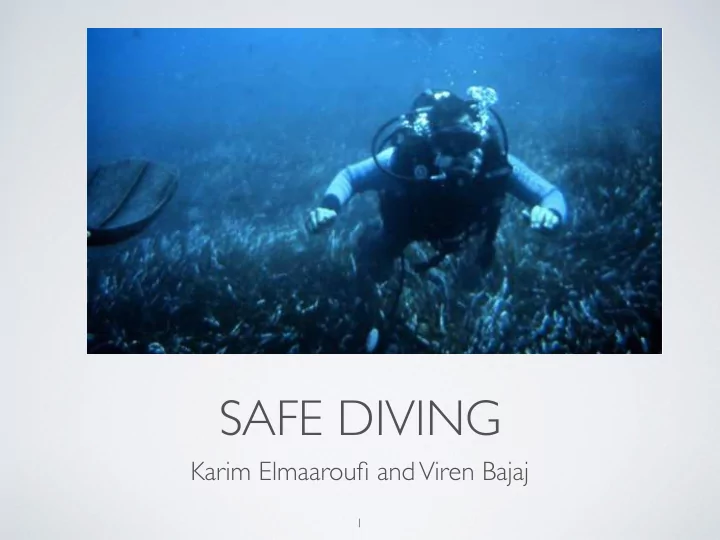

SAFE DIVING Karim Elmaaroufi and Viren Bajaj 1
OUTLINE 1. Motivation 2. Related work 3. Schema 4. Velocity determines heart rate 5. Heart rate determines VO2 consumed 6. Controller 7. Initial conditions and invariant 8. Future work 2
MOTIVATION • There are over 1,000 cases of Decompression Sickness (DCS) per year • Many cases are due to lack of awareness of remaining air supply • Prevent DCS and Arterial Gas Embolism • Most computers do not display remaining dive time, the ones that do cost over $2,000 3
RELATED WORK • US Navy most knowledgable body on SCUBA diving • Almost all of their results come from testing • Implantable Cardiac Medical Devices • Verification performed via clinical studies • Haque et al. noted a lack of verification systems for CPS 4
MODEL* determines determines Velocity Heart Rate VO2 cons. 1 2 * Time Triggered SAFETY O2 in tank >= depth / v ascent * VO2 max more conservative than VO2 ascent 5
1. VELOCITY HEART RATE determines HR ' = f min ⋅ f max ⋅ f d ( HR − HR min ) 2 f min ( HR ) = 1 − e stdev 35 beats HR min = cond min ( HR max − HR ) 2 f max ( HR ) = e − 1 stdev HR max = 200 beats min 6
1. VELOCITY HEART RATE determines f d ( HR , v , t ) = − α ⋅ cond ⋅ ( HR − L ( v , t )) α = 0.08 s − 1 α 3 = 4 beats ⋅ min − 1 ⋅ mM L ( v , t ) = α 3 ⋅ L cond ( v ) ⋅ L t ( t ) L base = 1 mM L max = 9 mM α 6 = 1.8 L cond ( v ) = L base + ( L max − L base ) ⋅ e α 6 ( v − v max ) v max = 8.88 cond α 7 = 2700 s − 1 − t L t ( t ) = 1 − e α 7 7
PROBLEM? • TOO COMPLICATED • Multiple exponential terms in the differential equation — ‘e’ not in the syntax for d 𝓜 • No algebraic intuition of solution — author numerically fit the data for runners 8
SOLUTION? • SIMPLIFY ! • Aspects to replicate in simplified dynamics: • intensity (velocity) should determine max heart rate achieved (steady state) • velocity should affect time taken to reach that steady state • “reach” = come within 1 beat/min of steady state 9
SOLUTION − t ln( HR ss − HR init ) ( − 20 v + 30) HR = HR ss − ( HR ss − HR init ) e v max v HR ss = HR min + ( HR max − HR min ) Steady State: v max ln( HRss − HRinit ) v → v max Time scale: As , HR → HR ss − 1 v ( − 20 + 30) v max Good approximation. usually within 1% of HR ss 10
− t ln( HR ss − HR init ) ( − 20 v + 30) HR = HR ss − ( HR ss − HR init ) e v max HR init = 80 bpm v = .5 v max HR ss = 130 bpm 11
DYNAMICS c HR ' = − ( HR − HR ss ) − 20( v ) + 30 v max 2.71828 c = HR ss − HR init OK to approximate e because: • c is a constant, not part of dynamics • computer also approximates value of e 12
2. HEART RATE VO2 CONS determines % HR max = 0.6463*% VO 2 max + 36.8 kg *min = 288 l ml VO 2 max = 60 (for 80kg diver) min HR max = 200 bpm VO 2 max * HR − 36.8 VO 2 = 0.6463* HR max 0.6463 VO 2 max VO 2' = HR ' 0.6463* HR max 13
FINAL VO2 DYNAMICS VO 2 max c VO 2' = ( − ( HR − HR ss ) ) − 20( v 0.6463* HR max ) + 30 v max 14
CONTROLLER 15
INITIAL INVARIANT CONDITIONS HR min <= HR <= HR max Invariant ... + Tank >= depth * VO 2 max depth max = Tank v asc * v asc VO 2 max VO 2 <= VO 2 max T > 0 v < v max depth < depth max HR max = 200 HR min = 60 v asc = .54 v max = 3 VO 2 max = 288 16
FUTURE WORK • Require lots of test data for divers to better fit model parameters • Prove safety of Maria’s (complex) model • Omar designed a wrist computer for under $300 • Prototype expected this summer 17
Thanks! 18
Recommend
More recommend